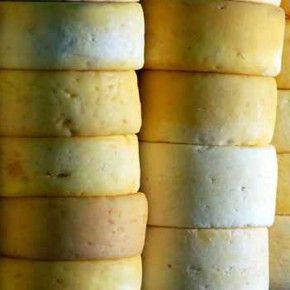The theme of an eternal discussion among sommeliers, the pairing of wine and cheese is without a doubt the most difficult. This despite the fact that both are a result of the blending of yeast and bacteria. A good cheese can better a low quality wine or a powerful cheese can devastate a fine wine.
To enter full force into the debate, we are going to break with myth, taking the risk of disappointing traditionalists: The best red wines do not make the best pairings with cheese. Also, without exception, dairy hardens the tannins in red wine, causing the aftertaste to become bitter and austere. If you do not wish to break with the traditional red wine-cheese marriage, it is best to choose a red that is light, simple, and has as few tannins as possible. In contrast, white wines are more versatile and give freshness to the union. Wines which are semi-dry and sweet are also good allies to give sweetness and roundness to strong or spicy cheeses.
If one is to be a purist, s/he must forget the large assortment of cheeses that exist. It is true that there exists a variety of cheese, the softest or the strongest and most rustic can create harmony in a dish. But in this case, finding a wine that can offer a good marriage with all of the diverse cheeses the world has to offer, presents an unsolvable puzzle. It is preferable, therefore, to gather an assortment of cheeses that come from the same theme or family: a selection of blue cheeses or goat cheeses, for example.
There are approximately nine cheese families. The following is a quick overview of each family with some of the original wine pairings:
1. The Fresh Cheeses: Brousse, neufchâtel, etc
-Made from all kinds of milk, these cheeses are not matured
–Wine Pairing: Should be limited to a few dry, lighter white wines. Albariño, Aligoté, or Chenin blanc and Viura that have not been aged in casks.
2. The White Cheeses made from pasta filata: Mozzarella, Oaxaca, etc.
–Wine Pairing: These bland cheeses are paired the same way the Fresh Cheeses are.
3. The Exterior Mold Cheeses: Camember, Brie, Chaource, Billat Savarin, etc.
-Raw and never pressed, these cheese generally made from cow’s milk are flowered (planted) with Penicillium Candidum, which is responsible for their characteristic white outer layer. From a blended texture, these become potent with flavor as they are aged.
–Wine Pairing: Chose very light red wine of the Merlot o Pinot Noir variety. A rose wine is also a good option, a very mature camembert beats any other wine.
4. The Washed Rind Cheeses: Maroilles, Pont-l’Evêque, Livarot, Munster, Epoisse, etc.
-Cow cheese washed with a salt brine during maturation. These are cheeses with a creamy texture, and are surely the most aromatic and flavorful.
–Wine Pairing: For me, these cheeses are the most exquisite, but are the true assassins of wine. They are the most difficult to pair, but a semi-sweet or sweet wine may be the best choice to round out the mix. Try a Riesling or a Gewurstraminer.
5. The Blue Cheeses: Roquefort, Stilton, Gorgonozola, etc.
-Made from cow or goat milk these stars of the dairy world are characterized by its greenish-blue veins, due to the action of Penicillium roqueforti or Penicillium gorgonzola.
–Wine Pairing: We need to seek a wine that reduces the persistence of the level of spice that is consistent with the complex taste of Penicillium. An aged Oporto, an Ice Wine, or a Hungarian Tokaji Aszu are all good options.
6. The Natural Rind Cheeses: Saint-Maure, Crottin de Chavignol and a multitude of cheeses from the Mediterranean and its islands.
-Often made from goat milk and sometime from sheep milk, these various cheese shapes (pyramids, cylinders, lots, corks, etc.) are tasty and slightly acidic.
–Wine Pairing: Sauvignon-Blanc is without a doubt your best choice to accompany these cheeses. Try Sancerre, Pouilly-Fumé, or an auromatic New Zealand Sauvignon-blanc.
7. The Uncooked Pressed Cheeses: Manchego, Cheddar, Gouda, Edam, Cantal, Saint Nectaire and numerous Tommes from the mountains of Europe
-Made from cow, sheep or goat milk, depending on the cheese or designations. It is hard to describe a taste synthesis for a group as diverse as this.
–Wine Pairing: Let yourself be seduced by a Rhone Valley Viogner, a Hugary Furmint, or a Californian Chardonnay.
8. The Cooked Pressed Cheeses : Parmesano, Comté, Emmental, Gruyére, etc.
-Hard Cheeses which over time develop a complex and fine aroma. The bouquet declines into nut, dried fruit, and dried herb aromas.
–Wine Pairing: Those white wines aged in oxidation are particularly appropriate for this group. In this case Vin Juane (Savagnin) from French Jura, Del Sercial de Madera or Fino Jerez from Andalusia.
- Cheeses
- Different cheese varieties
- Red and White Wine








